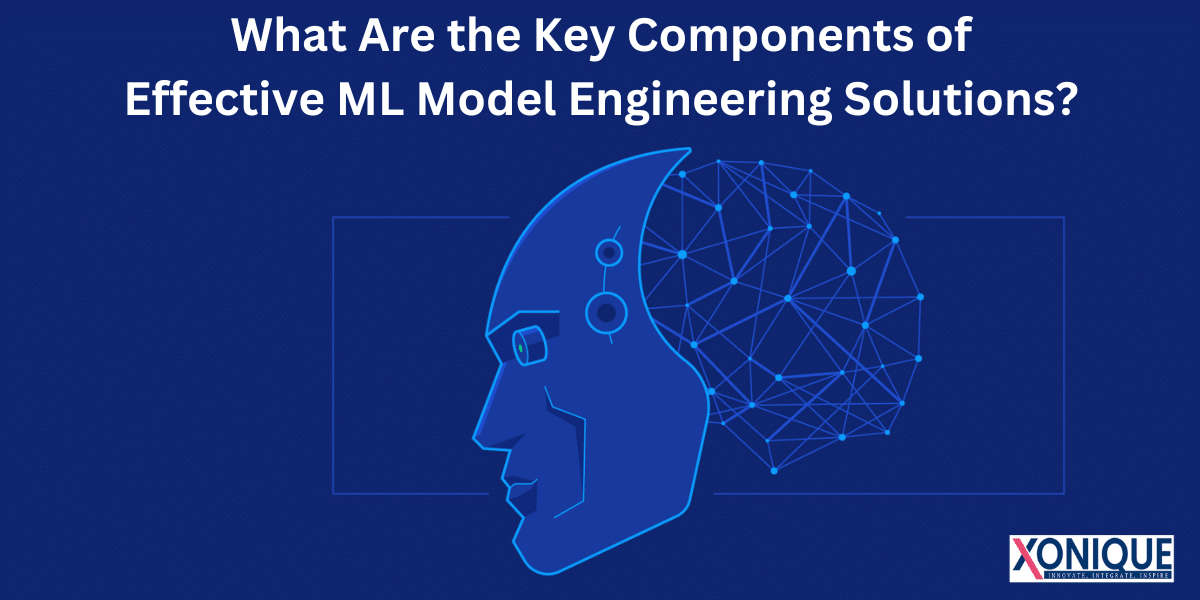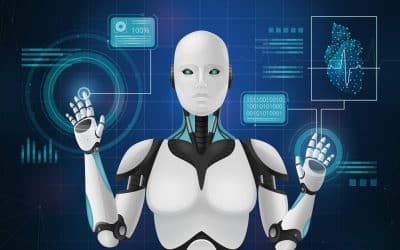Machine learning engineering involves the application of scientific theories, tools, and methods to develop and create complicated computer systems. From data gathering to model training, machine learning engineering provides real-time machine learning models that can serve users. Companies looking to develop flexible, simple-to-manage, and highly efficient machine-learning programs should know the importance of creating a machine-learning architecture.
Creating a robust ML structure with a well-thought-out data pipeline will result in higher algorithm efficiency, less time spent in experimentation and development, deployment and maintenance, and reduced testing and debugging. An efficient architecture will also guarantee the machine learning system’s security and integrity, allowing for continual development.
The ML Model Engineering Solutions infrastructure provides the base upon which models for machine learning are designed and put into use. As models are different in different projects, machine learning infrastructure implementations differ. However, there are fundamental elements that any machine learning infrastructure must have to function correctly.
This article explains these parts and outlines the essential elements to consider when constructing the machine learning framework.
What Is A Machine-Learning Model?
Machine learning models are computer programs that detect patterns and make decisions based on an undiscovered data set. For example, models can parse and accurately discern the meaning in previously unseen sentences or words in neural language processing learning. A learning model is taught to detect objects like dogs or cars for image recognition.
The machine learning model can accomplish these tasks after being trained using a vast data collection. During the training phase, an ML algorithm is made to detect particular patterns or outputs within the database by the job. This process usually results from the computer program that follows specific rules and structures, such as the Machine Learning Model.
Machine Learning Best Practices To Follow
This comprehensive guideline provides an overview of the best practices to follow to avoid the most common errors when using machine learning. It is designed to help you better understand the most effective practices for every area of machine learning.
Ensure The ML Model Is Necessary
Although many companies want to be part of the ML trend, the machine-learning model could not prove financially viable. Before investing your time and money in developing a machine learning model, you must determine the issue and evaluate how much machine learning and MLOps can benefit your specific needs. Small-scale businesses need to be more cautious as ML models consume money that is not accessible. Recognizing areas with a problem and having the correct data to implement machine learning strategies is the first step towards making a good model. This is the only method to increase the profit of your company.
Collect Data For The Chosen Objective
Although use cases have been discovered, data availability is the most critical factor for effectively implementing an ML model. An organization’s initial ML model must be straightforward, but it should choose targets that an enormous quantity of information can support.
Develop Simple & Scalable Metrics
The first step is to create scenarios for the development of the ML model. The business and technical metrics must be developed based on the scenarios. The ML model will perform more effectively with a clearly defined purpose and metrics for measuring these goals. Processes currently in place to achieve the company’s goals should be thoroughly reviewed. Recognizing where the process encounters difficulties is the most crucial step to automatizing. Finding techniques for deep learning which can address the present issues is essential.
Right Infrastructure Components
The ML infrastructure comprises various components, associated processes, and suggested solutions for ML models. Incorporating machine learning within business practices is a way to expand the infrastructure built with AI technology. Investing in developing the whole infrastructure after developing ML modeling is only advisable. Many aspects like containers, orchestration software, multi-cloud environments, hybrid environments, and agile architectures must be implemented gradually, allowing for maximal scaling.
Cloud-Based As Opposed To On-Premise Infrastructure
If companies are beginning to implement machine learning and machine learning, they should use cloud-based infrastructure first. Cloud-based infrastructures are cost-effective, easy to maintain, and adaptable. A few industry giants provide significant assistance to cloud-based infrastructure. Cloud-based ML platforms with many options are now ready for modification. Big companies like GCP, AWS, Microsoft Azure, and others. They have specific infrastructure for ML components that are ready for use. Cloud-based infrastructure comes with lower setup expenses and better service by ML Model Engineering Company. Also, it can be scaled with diverse-sized computing clusters.
Infrastructure on-premise can be incorporated with the most readily accessible learning servers, such as Lambda Labs, Nvidia Workstations, and others. Workstations for deep learning can be designed entirely from the ground up. In-house infrastructure models require significant initial investments. However, on-premise solutions have more advantages in terms of security if multiple models of ML can be used to automate enterprise processes. Ideally, ML models must use an amalgamation of cloud-based infrastructure and in-house systems to varying degrees.
Make The Infrastructure Scalable
The proper infrastructure for the ML model depends on your business model and goals for the future. The infrastructure should be able to support distinct models for training and serving. It lets you keep developing your model using advanced functions without altering the serving model. Microservices architecture can be instrumental in the creation of model encapsulation.
Understand Data Quantity Significance
The ability to build ML models is achievable in the presence of a vast quantity of data. Raw data can be crude. However, before ML models, you must extract relevant details from the information. Data collection should start by analyzing your existing systems within the business. It will provide all the necessary information to create your ML model. If the availability of data is low, use transfer learning to obtain the most data you can.
If raw data is accessible, you must deploy feature engineering to process the information. The data collected needs to be modified to make it sound like training data. Raw inputs transformed into features can be helpful when designing and modeling ML data.
Data Processing Is Crucial
The very first stage of data processing is collecting data and processing. Feature engineering is recommended in data preparation to link important features to information. Data wrangling metrics should be utilized in the data analysis stage. Exploratory data analysis uses data visualization to comprehend information, conduct sanity tests, and verify the accuracy of information. As the data analysis process matures, the data analysts incorporate continual inputs of data and the appropriate transformations across various analytical entities.
Data validation is necessary each time an ML pipeline or the data pipelines are used for model training. If data drift is detected, the ML model needs to be retrained. If anomalies in data are identified. The pipeline’s execution has to be suspended until the anomalies are taken care of.
Prepare Data For Use Throughout ML Lifecycle
Implementing and understanding good data science practices play crucial roles in preparing data for machine learning applications. The data sets must be categorized according to features and adequately documented for use throughout the ML process.
Develop a Robust Model
ML models’ validation, testing, and monitoring are essential without the ML model pipeline. Model validation must be carried out before the model enters production. The measure of robustness should be a necessary guideline for validating models. A model selection should be done by analyzing the robustness metrics. If the sturdiness of the model chosen cannot be increased to match standard benchmarks, then the model must be discarded, and a completely different model should be selected. Determining the best test cases and generating usable scenarios is essential for continually training ML models.
Develop & Document Model Training Metrics
Making incremental models using checkpoints can make your machine-learning framework resilient. Data science is a complex field involving various indicators and can become challenging to understand. Metrics that measure performance should always be given priority over fancy metrics. An ML model needs continuous training, and the model’s information should be utilized with every iteration. Production data can be helpful at the initial stage. Utilizing serving model data to create ML models for training will aid the real-time implementation process.
Fine Tune The Serving ML Model
Models that serve require constant surveillance to detect errors at the beginning of the process. This is a requirement for a human being on the line because unacceptable events must be identified and permitted. Regular monitoring should be planned during the service phase in the ML model to verify that the model operates as it is supposed to act. The user’s feedback loop must be integrated into the model maintenance process to establish an effective incident response strategy.
Monitor And Optimize Model Training Strategy
Intensive training is necessary for the success of model production. Continuous integration and training are essential to ensure that your ML model can solve business issues. Accuracy may differ depending on which training session was used at its inception. However, subsequent batches using the service model will be more quality. Each object instance must be accurate and uniform to ensure the strategy is optimized for training.
Components Of ML Model Engineering Solutions
It is essential first to comprehend the machine learning framework’s parts before diving into ML Model Engineering Services.
Model Selection
Model selection for machine learning is deciding on an appropriate model. It determines the type of data, the tools utilized, the components needed, and how they are connected.
Data Ingestion
The ability to insulate data is essential to every machine-learning system. This capability is required to gather data to train models, apply, and improve. Regarding tooling data ingestion, you need access to data sources as well as processing pipelines and storage. The tools must be adaptable, scalable, and highly efficient. In most cases, extract, load, transform (ELT) pipelines and data lakes are added to satisfy these demands.
Data ingestion software allows information from various sources to be compiled and stored without the need for substantial upfront processing. Teams can benefit from live data in real-time and cooperate in the design of databases.
ML Pipelines Automation
Various tools can be used to automate machine-learning workflows based on scripts and event triggers. Pipelines can be used to analyze data, create models, monitor procedures, and distribute outcomes. Pipelines allow teams to concentrate on more advanced work while assisting in increasing effectiveness and ensuring the uniformization of procedures.
If you are developing your infrastructure, you could build your tools from scratch by independently connecting and orchestrating them. Additionally, you can use pre-built self-contained pipelines, like ML Flow Pipelines or Apache Airflow. Read more about automated machine learning.
Monitoring And Visualization
Machine learning monitoring and visualization are used to provide a perspective on how well workflows are running and how precise model training is, and to draw insight from model training results. Visualizations may be incorporated anywhere in machine learning workflows, allowing groups to rapidly analyze system data. Monitoring needs to be integrated across.
When integrating monitoring and visualization into your machine-learning infrastructure, it is essential to ensure that your tools can consistently ingest data. The solutions must integrate with the various data sources to provide relevant information. Also, it would help if you took note of the tools and resources needed to operate. Be sure you’re picking solutions that perform well and will only create one resource with your training or deployment methods.
Model Testing
Tests of machine learning models require using tools in both the training and deployment phases. The tooling is used to evaluate models using manually labeled datasets to verify that the model’s outputs are in line with the desired outcome.
To set up machine-learning testing, you must integrate monitoring, data analysis, and visualization tools into your existing infrastructure. You must also create and control automated environments. During setup, you must run integration tests to verify that your components do not cause mistakes in other components or adversely impact your tests’ results.
Deployment
The deployment is the last step you must consider in your architectural model. This is the process that packages the model you have created and allows the development teams to integrate it into applications and services.
If you offer Machine Learning as a Service (MLaaS), it could be necessary to deploy the model into production. This allows you to collect data and then provide the results to customers. Most often, MLaaS involves containerizing models. If models are stored in containers, you can offer them as distributed, scalable solutions regardless of the end-user’s settings.
Inference
When you are in the process of deployment in the deployment phase, it’s essential to look at deep learning models and pick the ones that will best meet your requirements for continuous processing of the new data. The framework you choose should improve the framework to meet your requirements for performance in production while not exhausting the hardware resources. For example, a computer vision system running inside auto-piloted vehicles must make inferences at a speed of milliseconds and consider the available hardware onboard the car.
Moving models from framework to framework, depending on the production requirements, has become much easier over the last few years due to the creation of universal model file formats. These formats allow you to convert models easily across libraries, like the Open Neural Network Exchange (ONNX).
Machine Learning Operations (MLOps): ML Engineering For Production Models
MLOps is an essential ability in machine learning engineering. The technology is focused on reducing the time it takes to transfer models from machine learning into production and then manage and monitor them. MLOps can be a cooperative task of data scientists, DevOps engineers, and IT.
MLOps is a methodological approach that helps improve the efficiency of machine learning and AI solutions. By adopting an MLOps methodology, data scientists and engineers in machine learning work to implement continuous integration and deployment (CI/CD) methods. This allows monitoring, validation, and governance for ML models and allows for faster modeling development and deployment.
Making machine learning-based systems can be difficult. The lifecycle of machine learning consists of numerous complex parts, such as data collection, data preparation, model training, model tuning, deployment, model monitoring, and explanation. It also requires coordination and transfer of tasks between groups that range from data engineering science to ML.
It is much work to keep these systems functioning in tandem and being effective. However, it is worth it if using MLOps facilitates experiments, iteration, and continual improvement throughout the entire lifecycle of machine learning.
How To Set Up Your ML Architecture?
An appropriately designed architecture could significantly impact the efficiency of the model’s training speed and generalizability. Here’s an excellent example of what teams must take while developing their machine-learning framework:
Create The Statement Of The Problem
What problem are you attempting to resolve? Do you need to solve a classification regression or another kind of problem? Knowing the problem will assist you in choosing the right design and type of model.
Select The Ideal Framework
Machine learning frameworks can provide various levels of usability and flexibility. Choose one compatible with your particular project’s requirements and expertise. TensorFlow, PyTorch, and scikit-learn are all popular options.
Choose Model Components
Every layer in your model is designed to serve a particular function. Think about the following factors:
- Preprocessing and Input Layers
- Neuron Configuration and Hidden Layers
- Activation Functions
- Output Layer
Join The Layers, And Then Build The Flow
Using hidden layers, find out how information is transferred between the input layer and the output layer. This layer progression is the structure of the model. Techniques such as dropping out, batch normalization and regularization for L2 should be employed to decrease overfitting and increase model generalization. Imagine the structure. You can do this by using visual tools, such as diagrams and flowcharts, which can help you identify problems with the structure.
Conclusion
Following the top guidelines and grasping the essential components of engineering solutions for ML models, it is possible to create a flexible ML model that needs only minimal modifications. Ideal ML models integrate seamlessly into the existing system. The ML model must always leave space for improvements, as business and information demands change frequently.
To build a system that efficiently processes data and accomplishes the goal, you must have an in-depth understanding of your issue, the right methods, and an innovative strategy. Think about the tools, components, and best practices listed earlier, and you’ll be well on the path to creating a strong machine-learning framework for your venture.











